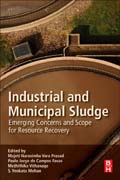
Industrial and Municipal Sludge: Emerging Concerns and Scope for Resource Recovery
Vara Prasad, Majeti Narasimha
de Campos Favas, Paulo Jorge
Vithanage, Meththika
Mohan, S.Venkata
Sludge is an expensive and problematic byproduct of the wastewater treatment process. While there are numerous treatment options, most were developed over a century ago. Industrial and Municipal Sludge: Emerging Concerns and Scope for Resource Recovery latest technologies and techniques to design and optimize sustainable sludge treatment processes and recovery operations.Divided into four sections, Industrial and Municipal Sludge: Emerging Concerns and Scope for Resource Recovery begins with a characterization of the various types of sludge, their sources and management strategies. This is followed by five sections speaking to issues and technologies for recovery such as: Emerging contaminants in sludge (Endocrine disruptors, Pesticides and Pharmaceutical residues, including illicit drugs/controlled substances); Bioleaching of sludge [with an enriched sulfur-oxidizing bacterial community; Recovery of valuable metals from sludge (Bioleaching and use of sulfur-oxidizing bacterial community; Biogas production by continuous thermal hydrolysis and thermohilic anaerobic digestion of waste activated sludge. In addition, the book includes numerous tables & flow diagrams are included to help comprehend the subject. Includes numerous tables and flow diagrams to assist in the comprehension of new and existing sludge treatments and resource recovery technologyCovers biogas production by continuous thermal hydrolysis and thermophilic anaerobic digestion of waste activated sludgePresents information on the recovery of valuable metals from sludge (bioleaching and the use of a sulfur-oxidizing bacterial community)Includes opportunities and challenges in the biorefinery-based valorization of pulp and paper sludge INDICE: Section 1: Sludge: Sources and Characterization 1. Sludge from waste water treatment plants 2. Sludge from pulp, tannery and distillery industries 3. Sludge from oil refinery 4. Sludge from chemical industry 5. Sludge from antibiotic wastewater treatment plants- Fate of antibiotic resistance 6. Earthworms converting milk processing industry sludge into biomanure Section 2: Sludge Management 7. Activation, conditioning and engineering of sludge 8. General considerations on sludge disposal 9. Sludge legislation (comparison between different countries) 10. Enhanced sludge degradation process using a microbial electrolysis cell 11. Sludge dewatering - Processes for enhanced performance 12. Rheological characterization of digested sludge Section 3: Contaminants in Sludge and Treatment strategies 13. Ecological and human health risks (general aspects of sludge ecotoxicity and public health) 14. Emerging contaminants in sludge (Endocrine disruptors, Pesticides and Pharmaceutical residues, including illicit drugs/controlled substances, etc.) 15. Traditional contaminants in sludge (Poly Aromatic Hydrocarbons (PAH) and Poly Chlorinated Biphenyls (PCBs), dioxins, perfluorinated chemicals, alkylphenol surfactants, etc.) 16. Bioleaching of sludge [with an enriched sulfur-oxidizing bacterial community 17. Sludge as medium for degradation of textile industry effluents Section 4: Valorization of Sludge as a Resource 18. Fertilizer for agriculture/ Manure for agro-forestry Sludge ash to horticultural crops 19. Sludge multifunctions in a phytobiome - (Forest and plantation application incl. microbial aspects) 20. Co-composting of sewage sludge and wetland plant material from a constructed wetland treating domestic wastewater 21. Biochar production from sludge 22. Phosphorus extraction and sludge dissolution 23. Recovery of valuable metals from sludge (Bioleaching and use of sulfur-oxidizing bacterial community 24. Water-based paint sludge from automotive industries Section 5: Energy recovery from sludge 25. Co-processing of sewage sludge in cement kiln 26. Biorefinery-based valorisation of pulp and paper sludge - opportunities and challenges 27. Volatile fatty acid yield from sludge anaerobic fermentation through biotechnological approach 28. Biogas (methane production) and energy recovery from different sludges 29. Biogas production by continuous thermal hydrolysis and thermohilic anaerobic digestion of waste activated sludge 30. Sewage Sludge based Microbial fuel cell
- ISBN: 978-0-12-815907-1
- Editorial: Butterworth-Heinemann
- Encuadernacion: Rústica
- Páginas: 616
- Fecha Publicación: 01/05/2019
- Nº Volúmenes: 1
- Idioma: Inglés
